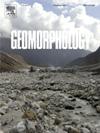Development of ‘SedCam’—A close-range remote sensing method of estimating suspended-sediment concentration in small rivers
IF 3.1
2区 地球科学
Q2 GEOGRAPHY, PHYSICAL
引用次数: 0
Abstract
The adaptation of suspended-sediment surrogate technologies continues to rapidly expand across geomorphology and fluvial sediment monitoring efforts. Over a decade of research and development shows increased reliability and accuracy of in-situ surrogates with reduced program cost as compared to traditional sample-based methods, but environmental fouling and probe damage can be problematic. The SedCam technique is a unique non-contact close-range remote sensing method to estimate suspended-sediment concentration from multispectral imagery of a river surface. In contrast to typical airborne- or satellite-based platforms, SedCam uses broadband sensors with lower spectral resolution (three bands covering wavelengths of 340 to 1100 nm) but greater spatial resolution (0.5 mm pixel size; equivalent to medium to coarse sand) and temporal resolution (15-min intervals during daylight hours). This paper summarizes lessons learned from two studies, utilizing three consumer-grade digital cameras (each with different spectral signatures) at two different rivers (each with different sediment characteristics). More than 90,000 images and 174 concurrent physical samples represent a collective period of 26 months. A subset of these data pairs supports the development of four regression models. Statistical diagnostics show model error can be <40 % when surface point samples are used, with coefficients of determination ≥0.90. This novel approach shows similar accuracy to other surrogate methods such as instream turbidity. Results of this study indicate that optimizing spectra based on expected suspended-sediment concentration increases model performance.
求助全文
约1分钟内获得全文
求助全文
来源期刊

Geomorphology
地学-地球科学综合
CiteScore
8.00
自引率
10.30%
发文量
309
审稿时长
3.4 months
期刊介绍:
Our journal''s scope includes geomorphic themes of: tectonics and regional structure; glacial processes and landforms; fluvial sequences, Quaternary environmental change and dating; fluvial processes and landforms; mass movement, slopes and periglacial processes; hillslopes and soil erosion; weathering, karst and soils; aeolian processes and landforms, coastal dunes and arid environments; coastal and marine processes, estuaries and lakes; modelling, theoretical and quantitative geomorphology; DEM, GIS and remote sensing methods and applications; hazards, applied and planetary geomorphology; and volcanics.
 求助内容:
求助内容: 应助结果提醒方式:
应助结果提醒方式:


